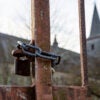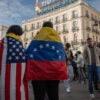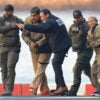Appearing before the Senate Select Committee on Intelligence on January 31, Director of National Intelligence (DNI) James R. Clapper warned that the “2011 plot to assassinate the Saudi Ambassador to the U.S. shows that some Iranian officials—probably including Supreme Leader Ali Khamenei—have changed their calculus and are now more willing to conduct an attack in the U.S. in response to real or perceived U.S. actions that threaten the regime.”
In October, U.S. officials accused Iran of plotting to assassinate the Saudi ambassador in Washington with hired assassins from a Mexican drug cartel. The Obama Administration said the plot was devised by an Iranian-American with ties to Iran’s Islamic Revolutionary Guard Corps. It was foiled when the Iranian-American mistakenly hired a paid Drug Enforcement Administration informant to kill the Saudi Ambassador by bombing his favorite restaurant in Washington. Iranian officials have denied any role in the plot. Despite a long record of instances in which Iran’s top leaders have ordered crude terrorist attacks by surrogate groups, some in Washington continue to gloss over the plot as a “rogue operation.” But there should be no doubt that Iran’s Revolutionary Guards operate directly under the command of Iran’s Supreme Leader, Ayatollah Ali Khamenei.
As The Washington Post noted, Clapper’s reference to Khamenei on January 31 marks the first time U.S. officials have mentioned Iran’s Supreme Leader in connection with the plot, signaling new belief that the alleged willingness to authorize such attacks comes directly from the top. Clapper concluded that the U.S. could expect continued uncertainty regarding Iran’s willingness to sponsor future attacks in the United States or against our interests abroad.
The DNI’s assessment underscores the ongoing need for serious U.S. attention to the Iranian threat in the Americas and the potential linkage between Mexican criminal organizations, anti-American regimes such as that of Hugo Chavez in Venezuela, and the masterminds of Islamist terror. DNI Clapper noted: “multiplicity and interconnectedness of potential threats—and the actors behind them…constitute our biggest [security] challenge.”
Heightened attention to Iran follows Iranian President Mahmoud Ahmadinejad’s January 2012 visits to Venezuela, Nicaragua, Cuba, and Ecuador and mounting tension over sanctions to stop Iranian nuclear proliferation and control of the vital Strait of Hormuz. Iranian terror operations on U.S. soil and in the Americas were the topic of congressional hearings in October and the subject of former Assistant Secretary of State for Latin America Roger Noriega’s perceptive and chilling review of Iranian maneuvering in the Americas in the latest issue of Commentary.
The DNI’s assessment also adds ammunition to the argument that the U.S. needs both a comprehensive report on and strategy for dealing with Iranian penetration into the Americas as proposed in the Countering Iran in the Western Hemisphere Act of 2012.
But most of all, the DNI’s assessment throws a spotlight on a long-neglected aspect of Iran’s hostile foreign policy: its extensive reliance on terrorism to advance its ideological agenda. Since the 1979 revolution, Iran’s leaders have used terrorism to defeat their internal rivals, consolidate power, advance the regime’s foreign policy goals, intimidate smaller countries, and support their campaign to expel western influence from the Middle East. The revolutionary Shia Islamist regime in Tehran sees itself as the leader of an Islamist awakening that is roiling the Middle East, and it poses as the champion of the Islamic world against the West, particularly the United States.
Iran has worked through a wide variety of terrorist groups, particularly the Lebanese Shia Islamist extremist Hezbollah, which Tehran created, trained, financed, armed, and directed. Iranian Revolutionary Guards worked closely with Hezbollah to perpetrate the October 1983 bombing of the U.S. Marine barracks in Beirut, Lebanon, which killed 241 Americans and helped pushed the Multinational Force peacekeepers out of Lebanon. Hezbollah also was involved in the 1983 bombing of the U.S. Embassy in Beirut that killed 63 people, including 17 Americans; the kidnapping of scores of American and western citizens who were held hostage in Lebanon; and the 1985 hijacking of TWA Flight 847 in Lebanon, which resulted in the murder of a U.S. Navy diver, Robert Stethem.
Iran also has longstanding shadowy links to al-Qaeda. Seth Jones, writing in Foreign Affairs, noted earlier this week that “Perhaps more disturbing, Iran appears willing to expand its limited relationship with al-Qaeda.” While Osama bin Laden’s terrorist network has been hammered in a global war of attrition against its cadres in Afghanistan, Iraq, Pakistan, and Yemen, Tehran has given refuge to many important al-Qaeda leaders. Although Iran sometimes claims that it has kept the terrorists under house arrest, they periodically have been able to support terrorist operations in other countries and Iran allowed many to go free in 2009 and 2010, including some members of bin Laden’s family.
The 9/11 Commission, which recommended that further investigation was needed to examine Iran’s ties to al-Qaeda, concluded that al-Qaeda may have assisted Iran in carrying out the June 1996 bombing that killed 19 U.S. Air Force personnel at the Khobar Towers residential complex in Saudi Arabia. The 9/11 Commission Report stated on page 60 that:
The operation was carried out principally, perhaps exclusively, by Saudi Hezbollah, an organization that had received support from the government of Iran. While the evidence of Iranian involvement is strong, there are also signs that al Qaeda played some role, as yet unknown.
Al-Qaeda’s facilitator within Iran initially was the Quds Force, the elite special forces unit within the Revolutionary Guards that serves as the spearhead of Iran’s Islamist revolution and functions as a liaison with foreign revolutionaries and terrorist groups. The Quds Force, which supports attacks against American personnel in Afghanistan and Iraq, reportedly was also involved in the plot to assassinate the Saudi Ambassador in Washington.
This was not the first time that Iran has plotted a terrorist attack in Washington. The regime previously ordered the assassination of Iranian opposition leader Ali Akbar Tabatabai in Bethesda, Maryland, in July 1980 at a time of high tensions between Iran and the United States over the hostage crisis. Iran’s stooge in that operation was David Belfield, an American Muslim convert who formerly worked as a security guard at the Iranian Interest Section in the Algerian Embassy. Belfield fled to Iran and lives there today as a pampered guest of the Iranian government.
Now that tensions are rising again with Washington, it looks like Tehran is falling back on old habits.






























4 Replies to “Latest Intelligence Assessment: Iran Poised to Target U.S. Homeland”